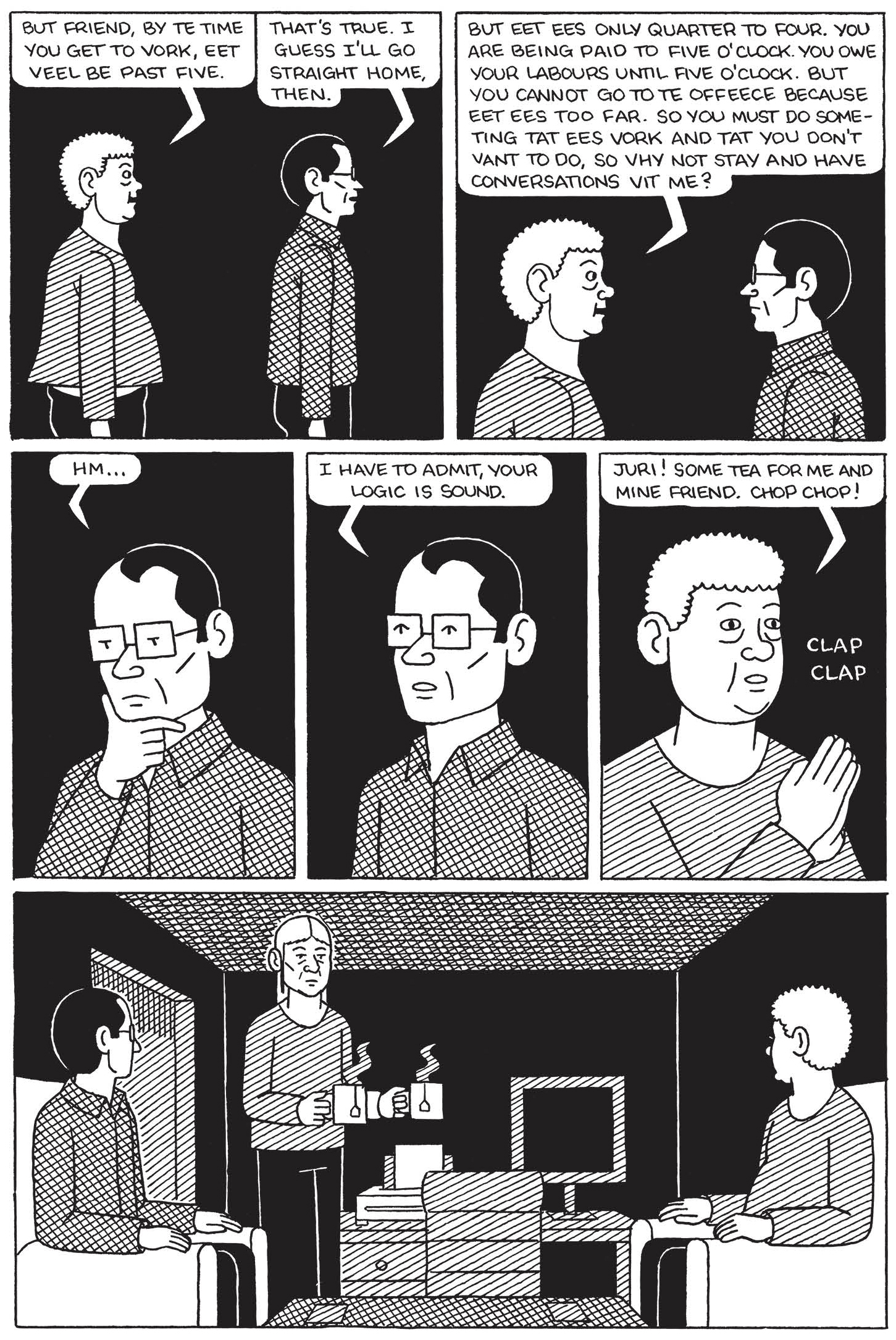Nick Maandag is a pragmatist. In his 2020 interview with The Comics Journal, he describes coming home from his job every night and laboring through a few panels: “…the drawing itself is totally mechanical and uninspired. I’m just putting down the shapes where they belong, putting down the dialogue where it belongs.” He portrays himself as someone who chose comics because they’re the right delivery system for the kinds of jokes he wants to tell. Likewise, Maandag’s characters are problem solvers. They relentlessly pursue modest goals, consistently striving toward higher planes of efficiency. His favorite settings are corporate offices and religious communities - places whose inhabitants are inescapably conscientious of their place in the hierarchy. His characters use galaxy-brain reasoning to attempt to outwit those systems, and most of the humor in his work comes from watching that clown logic boomerang as those characters land far away from their expected outcomes.
With 2019’s The Follies of Richard Wadsworth Maandag began putting out small anthologies, as opposed to one-offs - and not for thematic reasons, but to save some of the hassle of publishing and promoting. His mid 2010s breakout stuff tended to be high concept (libertarian dates socialist; CEO outlaws pooping on company time), but he’s since evolved into plots that are more difficult and less satisfying to explain. Characters move linearly from point A to point B to point C, but they cover so much ground and their decision-making is so abstruse that it would make any attempt to catalog the action seem like free association. The central story in Harvey Knight’s Odyssey depicts a power grab in a sunworshippers’ cult that somehow involves musical theater, a naked talk show, and opening a pet grooming salon.
Like his description implies, there’s a workmanlike quality to Maandag’s drawing. It often feels like a sort of bespoke clip art. From a distance, the most notable thing is the magnitude of clashing patterns - shirts and walls packed with diagonal lines that instantly displace the reader. His characters’ bodies appear to have only enough muscle to barely lift their arms. But the aesthetic choices are more about cumulative effect than consistent gratification. Maandag lists The Simpsons as a major influence. Like The Simpsons, Harvey Knight’s Odyssey rewards repeat engagement. Once you’ve acclimated to the visual language, little gags jump out from all over the place. As an artist, Maandag’s timing is impeccable. He lays out pages and panels in beats, using pauses, reveals and cutaways to lead overlapping jokes into multiple payoffs, giving his stories a wholly unique rhythm that could only exist in this medium.
Harvey Knight’s Odyssey is bookended by Maandag’s first published autobiographical comics since before his 2011 breakout, Streakers. Protagonist Nick still makes dubious choices—in “Full Day”, a stranger at a bodega lures him into a 90-minute drive to use a printer—but there’s at least one major difference between Nick and Maandag’s typical spotlight characters. In that TCJ interview, Maandag describes his older, “naïve” autobiographical work as having a “lack of detachment,” and his newer, “mature” work succeeds because there’s more distance between himself and his characters. That detachment carries over in his return to autobiographical stuff, and the character Nick has a similar detachment toward his own job in payroll. “Full Day” sees Nick solving other peoples’ problems instead of his own, not for personal gain but mostly because he’s on the clock - even if the on-the-clock mentality carries over after his workday ends. There’s no obvious motivation, he’s just a payroll guy playing the role of payroll guy even in his off hours.
The opening chapter, “The Plunge”, stands out in Maandag’s body of work for what it doesn’t do. Maandag’s stories tend to work like Rube Goldberg machines, with each decision cascading into the next. “The Plunge” takes its structure from one repeated event, with increasing anticipation for each repetition. Nick decides to start making his own coffee at work instead of buying it on the way, and his officemates become increasingly invested in his coffeemaking process. “The Plunge” is closer to anti-comedy than most of Maandag’s stuff. It builds humor, even suspense, from withholding the punchline. Maandag certainly knows his way around an anti-climax, but the relationship between expectation and payoff in “The Plunge” is particularly complex. The office workers don’t seem to lack self-awareness around their absurd devotion to Nick’s French press, but that also doesn’t stop them from leaning all the way into it while the fun lasts. The payoff is a small but valuable moment of transcendence for each of them. And, of course, it’s tempting to draw parallels between Nick’s coffeemaking practice and Maandag’s panels-every-night grindset. The mechanical routine simply frames a commitment to craft - uninspired drudgery that nevertheless gives way to brief moments of the sublime.
The post Harvey Knight’s Odyssey appeared first on The Comics Journal.



No comments:
Post a Comment